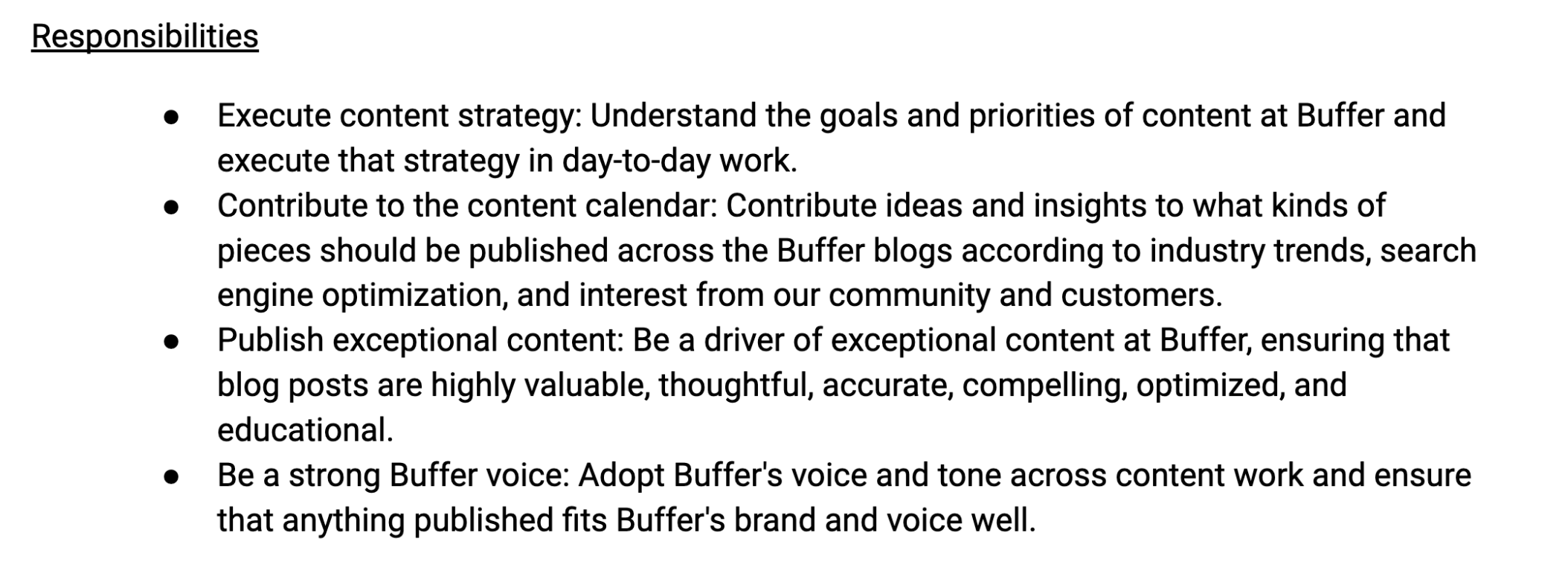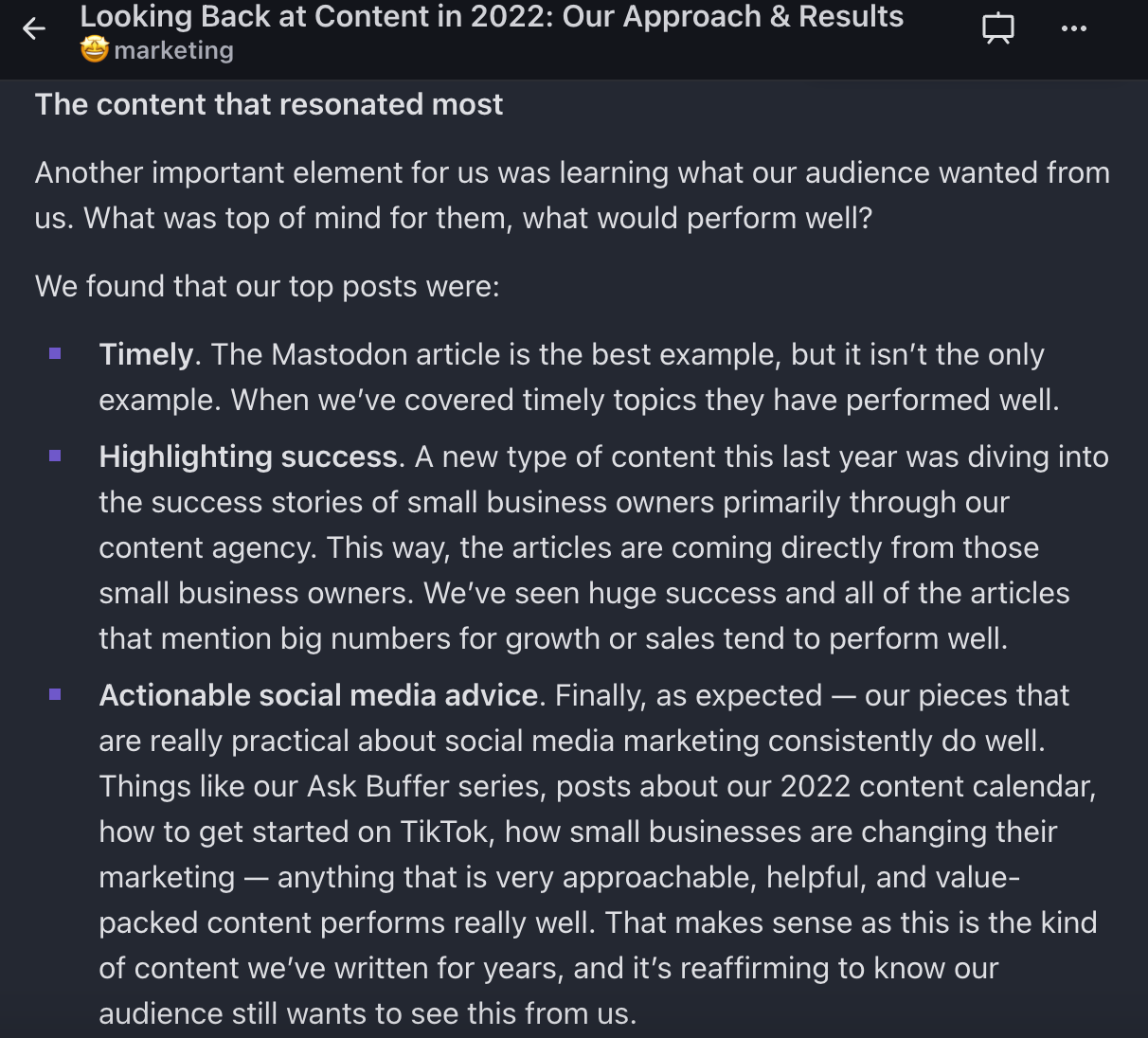After randomly deciding to count how many articles I had written 1.5 years into my time at Buffer, I realized I was about to hit 100 articles written for the Buffer blog.
It’s an awesome milestone, and I wanted to share the feeling of accomplishment. So I tweeted and posted on LinkedIn about it and received many congratulations and compliments about my writing.
Then I also got several questions about my writing process and motivation. The latter is pretty easy to answer – this is my job. I’m (and I say this with complete genuineness) pretty chill, thanks to my need for consistent internal motivation to do anything that requires significant effort. Thankfully, Buffer’s the kind of place where that effort feels like it’s worth it and is always rewarded.
However, there’s the first part – my process. I didn’t want to repeat myself to everyone who asked – so I wrote a whole article with every answer. I’ve documented some background about my time at Buffer, my writing process (which took longer than expected for something that’s part of my daily routine), and some of my advice for current and aspiring content writers.
Background of my time at Buffer
Short version: I’ve been at Buffer for 18 months and have grown significantly in my role and as a creator since I joined.
I applied for the Content Writer role in October 2021 and started in February 2022. In between was filled with excitement, anxiety, and anticipation because
- It’s BUFFER
- The job description was literally perfect for me
- I was hoping to move in-house, away from the hustle and bustle of agency life, to pursue writing for one company in one industry.
Still, I was in disbelief when I got the offer. Yes, I got through the interview process, and of course, I trust Hailley, the Head of Content, and Joel, the CEO at Buffer as well as all the folks who had a hand in the decision. I trust that out of all the applicants, I honestly was a good fit. But it’s hard to shake self-doubt, which I deal with very often.
However, I’m still here, 18 months and more than 100 articles later, so I must be doing something right. My role’s also shifted quite a bit. Here’s the original posting:

Compared to now, my role has changed quite a bit. I now:
- Help define content strategy,
- Write the weekly newsletter,
- Track content performance through our analytics,
- Run a guest posting program,
- Collaborate on team-wide marketing projects.
A look at my writing process
Publishing over 100 long-form articles in 18 months (approximately five a month) is no small feat, and I got a few questions about the writing process that helped me achieve it. Specifically, Kuba Rogalski and Anfernee Chansamooth asked directly about my writing process.
So, here’s how I take an article from idea to publishing and beyond.
Research and ideation
I fill out the content calendar with a mix of ideas pulled from research about keywords we need to target, current trends in the social media industry, questions from our audience, and instinctive knowledge of our content gaps.
When I started, I would get content ideas from Hailley based on what made the most sense for me to cover. Over time, as I grew comfortable with the social media space, I started to understand what would best move the needle for our core metric: page views.
Now that I understand both the Buffer brand and the social media industry/creator economy, I operate pretty much independently on idea generation. I’ll often place my ideas in the content calendar as they come and run them by the team as needed.
Outlining and drafting articles and emails
While hiring for the role I’d eventually fill, the Content team was essentially just Hailley, supported by an agency, so when I joined, we had to develop a new system for collaboration.
We’ve refined it well enough that the actual writing of articles is a science masquerading as art that goes like this:
- Outlining: I outline articles using the 30 percent outline format. While I rely less on this than I used to, it’s a helpful frame that’ll get you from idea to final product as quickly as possible.
- Title/H1: I’ll often come up with several options for potential titles before or after drafting. Sometimes I can only tell the best title for an article before I start writing it; other times, it’s obvious from the start.
- Keyword (if the article is SEO-driven): The keyword will determine the final URL we publish an article under, so it’s helpful for our social media manager Mitra, to have it before the blog goes live
- Introduction: I’ll typically start with one hook paragraph to grab a reader’s attention, then finish up with one thesis paragraph that’ll tell you what to expect from the article
- Headings and accompanying content: I’ll break up the article into H2s, 3s, and 4s for easy skimming and the on-page SEO benefits. I view headings as a “tell them what to expect” then deliver through the sections all the way to the conclusion.
I also write the weekly Social Media newsletter, which is more “fill-in-the-blanks” than anything. The most hands-on work there is optimizing the newsletter by A/B testing headlines, experimenting with new sections, and incorporating audience feedback about our design or existing content formats.
Editing feedback and revisions
When I first joined, Hailley would review my work, and I would review to make changes; she’d look again and then give me the go-ahead to publish. Over time, I’ve gotten better at writing in general and for Buffer specifically, so we only do one round of revisions before publishing.
I proofread using Grammarly as I’m writing, so editing is usually focused on making structural changes or fixing the overall tone and style of an article. Once done, I schedule the article in Ghost, our content management system.
Zero-click repurposing
I recently started sharing older articles to my personal social media to contribute to distribution. This is still a new part of my process and is a drop in the ocean at the moment. But it helps drive traffic to the blog and gives me something to schedule when I’m out of new ideas.
The tools and resources that power my writing
I work with a lot of tools daily, but here’s the stack I work with every day:
- Research & ideation: Keyword research in Ahrefs; an array of newsletters; content gaps; analytics, past performance
- Content management: Notion
- Outlining & drafting: Google Docs, Clearscope
- Article optimization (graphics, editing & proofreading): Grammarly, Unsplash, Canva
- Article publishing: Ghost
- Newsletter publishing: Customer.io
- Zero-click repurposing: ChatGPT, scheduling in Buffer
- Admin: Calendly, Slack, Otter.ai, Zoom
Of course, this doesn’t consider that I also write the newsletter, conduct interviews, keep track of analytics, and manage our guest posting program.
Some challenges I face as a content writer
While my writing and marketing skills seem like they’re really great, I struggle with a lot of things, mostly because I was a “gifted kid.” I could read very early, and for as long as I’ve understood how to put pen to paper, writing has come naturally to me. However, as I’ve gotten older, I’ve realized that writing’s about the only thing I find easy. And I’ve found myself in a career that’s only five percent talent.
As I shared in the introduction, I need internal motivation to work at something, especially things that frustrate me. And I’m not very good at sticking to a task if I don’t understand it, so I don’t do well with these frustrating things. However, that wouldn’t have given me the needed growth, so I had to learn or be left behind.
So, since I got my first writing job, I’ve approached everything with a beginner’s mindset. Analytics, coding basics, and building Notion databases have all become part of my job, but I didn’t know them initially.
It often took me a lot of trial and error to understand how a piece of content or a project or task I took on would fit into the broader scheme of a brand (whether personal or business). I definitely didn’t gain that instinctive understanding at Buffer until about six months in, and I’m still figuring it out for my personal brand.
I also still struggle with overestimating (and then overextending) myself by thinking I can take on more than I can. I struggle with procrastination due to perfectionism (these are old nemeses). I struggle because my environment isn’t always ideal, and my sense of creativity is sensitive to the slightest change.
So no matter what it looks like on the outside, I’m far from perfect and still have a lot of growing to do. Thankfully, I have the support of the Buffer team and the network of professionals that cheer me on every day.
Answering some FAQs about my writing process
What I’ve learned along the way
Michaela Mendes asked what I’ve learned along the way. It took me a bit of thinking, but I can pinpoint three main lessons from when I started at Buffer till now;
- When growing a blog, you’re at the mercy of the search engines but only up to a certain point – follow the rules as necessary, but don’t let that overcome the writing and its purpose.
- There’s no such thing as “too obvious” when breaking down information. Every main topic has sub-topics that also have sub-topics. You haven't run out of ideas until you get to the last atom of an idea.
- Give your readers what they want to the best of your ability. Online writing (as in writing from a brand, business, or otherwise) is to influence someone else. Sometimes that influence is for information or knowledge sharing (“Trust me, I’m an expert at [topic]”); other times, it’s transactional (“This is your challenge, this is how my product solves it, buy it from me.”)
I’ve also learned that I only have one talent (writing), and I’m fortunate it’s so versatile.
How data informs Buffer’s content
Danny Groner asked, “Can you share a couple of the metrics you pay attention to after you've published that determines the cadence and which topics, too, will follow suit?”
We mainly track pageviews and signups. Specifically, we focus on pageviews over 7, 28, and 84 days and wider pageviews broken up by blog, timeframe, etc. This is so that we can get a picture of how pieces perform individually and how our blog traffic is going.

However, as detailed as our tracking is, we’ve only been analyzing at a high level, which we’re working to change. We used to work with a combination of month-to-month analyses of content performance, a yearly overview, and an instinctive understanding of what content performs best to determine how to move forward but discovered we weren’t thinking high-level enough.
Now, Hailley and I are working on a project to analyze the past eighteen months of content performance across our main metrics. We’ve placed all the content we’ve ever tracked into relevant categories and plan to analyze the data to find top performers and their common threads (like our readers’ jobs-to-be-done or content format) and incorporate all our findings into future content.
Our thesis is that understanding and focusing on what content performs best will help the blog grow and tell us what our audience gravitates towards most, and help us help them.
What has helped me build out my workflow and write faster
Alice Lemee asked what helped me build my workflow and write faster.
Nothing has helped me more than immersing myself in each thing I need to tackle. There were things I already knew before joining Buffer. I knew how to write a decent SEO-optimized article, I knew how to use many online tools to enable my writing. But I’ve learned so much it makes my prior progress look like going from crawling to running a half-marathon.
- To get ideas for articles, I started following all the thought leaders, even remotely connected to social media and then, later, the creator economy.
- To learn about Buffer users’ most likely frustrations and get hands-on experience with their challenges, I started posting to social media more frequently using Buffer.
- To learn more about email writing and automation, I started a newsletter.
- To improve my marketing skills, I took Amanda Natividad’s Content Marketing 201, and I’m currently taking CXL’s Technical Content Marketing course.
- To understand Notion better, I built a database of resources.
Combined, all this effort has made writing for Buffer’s audience – excuse the drama – part of my existence. I live and breathe being a creator now, so I essentially write for myself.
What lies ahead
A structured writing process, coupled with continuous learning and adaptation, can lead to prolific content output that resonates with your audience. I don’t consider myself an expert, but if I had to give any advice on becoming a better writer, it’d be:
- Think beyond tactics and structure. Once you’ve learned the basics of writing online, you’ll need to further understand marketing, branding, and market research. Immerse yourself in your industry to generate impactful ideas and create meaningful work.
- When in doubt, use a template. With a structured outline (like the 30 percent format), you can avoid most of the worry about whether an article is optimized and focus on delivering quality writing to your reader.
Reflecting on my journey, from the first month at Buffer till now, it's clear that growth is a constant effort. I plan on being at Buffer for a while – I can’t wait to see how much I’ve grown in another 100 articles.

